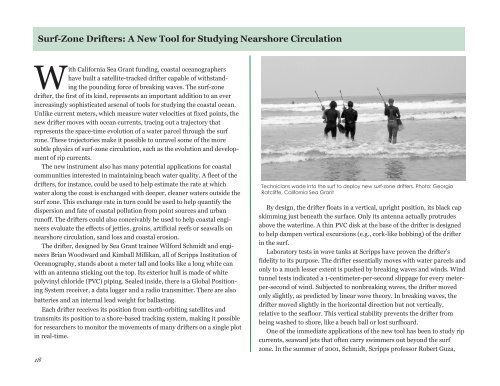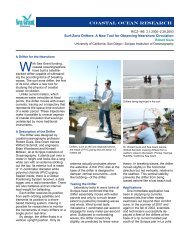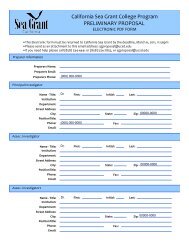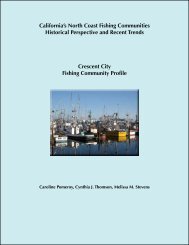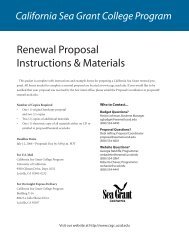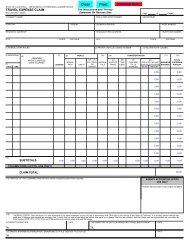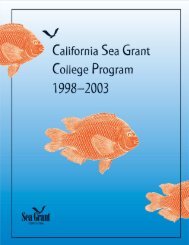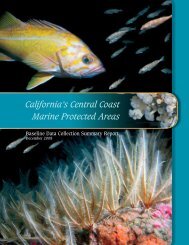2001â2002 - California Sea Grant - UC San Diego
2001â2002 - California Sea Grant - UC San Diego
2001â2002 - California Sea Grant - UC San Diego
Create successful ePaper yourself
Turn your PDF publications into a flip-book with our unique Google optimized e-Paper software.
Surf-Zone Drifters: A New Tool for Studying Nearshore Circulation<br />
With <strong>California</strong> <strong>Sea</strong> <strong>Grant</strong> funding, coastal oceanographers<br />
have built a satellite-tracked drifter capable of withstanding<br />
the pounding force of breaking waves. The surf-zone<br />
drifter, the first of its kind, represents an important addition to an ever<br />
increasingly sophisticated arsenal of tools for studying the coastal ocean.<br />
Unlike current meters, which measure water velocities at fixed points, the<br />
new drifter moves with ocean currents, tracing out a trajectory that<br />
represents the space-time evolution of a water parcel through the surf<br />
zone. These trajectories make it possible to unravel some of the more<br />
subtle physics of surf-zone circulation, such as the evolution and development<br />
of rip currents.<br />
The new instrument also has many potential applications for coastal<br />
communities interested in maintaining beach water quality. A fleet of the<br />
drifters, for instance, could be used to help estimate the rate at which<br />
water along the coast is exchanged with deeper, cleaner waters outside the<br />
surf zone. This exchange rate in turn could be used to help quantify the<br />
dispersion and fate of coastal pollution from point sources and urban<br />
runoff. The drifters could also conceivably be used to help coastal engineers<br />
evaluate the effects of jetties, groins, artificial reefs or seawalls on<br />
nearshore circulation, sand loss and coastal erosion.<br />
The drifter, designed by <strong>Sea</strong> <strong>Grant</strong> trainee Wilford Schmidt and engineers<br />
Brian Woodward and Kimball Millikan, all of Scripps Institution of<br />
Oceanography, stands about a meter tall and looks like a long white can<br />
with an antenna sticking out the top. Its exterior hull is made of white<br />
polyvinyl chloride (PVC) piping. <strong>Sea</strong>led inside, there is a Global Positioning<br />
System receiver, a data logger and a radio transmitter. There are also<br />
batteries and an internal lead weight for ballasting.<br />
Each drifter receives its position from earth-orbiting satellites and<br />
transmits its position to a shore-based tracking system, making it possible<br />
for researchers to monitor the movements of many drifters on a single plot<br />
in real-time.<br />
18<br />
Technicians wade into the surf to deploy new surf-zone drifters. Photo: Georgia<br />
Ratcliffe, <strong>California</strong> <strong>Sea</strong> <strong>Grant</strong><br />
By design, the drifter floats in a vertical, upright position, its black cap<br />
skimming just beneath the surface. Only its antenna actually protrudes<br />
above the waterline. A thin PVC disk at the base of the drifter is designed<br />
to help dampen vertical excursions (e.g., cork-like bobbing) of the drifter<br />
in the surf.<br />
Laboratory tests in wave tanks at Scripps have proven the drifter’s<br />
fidelity to its purpose. The drifter essentially moves with water parcels and<br />
only to a much lesser extent is pushed by breaking waves and winds. Wind<br />
tunnel tests indicated a 1-centimeter-per-second slippage for every meterper-second<br />
of wind. Subjected to nonbreaking waves, the drifter moved<br />
only slightly, as predicted by linear wave theory. In breaking waves, the<br />
drifter moved slightly in the horizontal direction but not vertically,<br />
relative to the seafloor. This vertical stability prevents the drifter from<br />
being washed to shore, like a beach ball or lost surfboard.<br />
One of the immediate applications of the new tool has been to study rip<br />
currents, seaward jets that often carry swimmers out beyond the surf<br />
zone. In the summer of 2001, Schmidt, Scripps professor Robert Guza,


